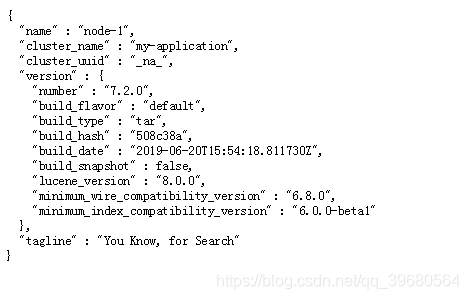社区微信群开通啦,扫一扫抢先加入社区官方微信群

社区微信群
社区微信群开通啦,扫一扫抢先加入社区官方微信群

社区微信群
[es@localhost bin]$ cat /etc/redhat-release
CentOS Linux release 7.6.1810 (Core)
获取安装包
wget https://artifacts.elastic.co/downloads/elasticsearch/elasticsearch-7.2.0-linux-x86_64.tar.gz

tar -zxvf elasticsearch-7.2.0-linux-x86_64.tar.gz -C /opt/
cd /opt/elasticsearch-7.2.0
vim config/elasticsearch.yml #修改配置文件
修改内容:
cluster.name: my-application #集群名
node.name: node-1 #节点名称
path.data: /data/es/data #数据存储路径
path.logs: /data/es/logs #日志存储路径
network.host: 192.168.110.112 #本机IP,可以写0.0.0.0
http.port: 9200 #访问端口
discovery.seed_hosts: ["127.0.0.1:9200"] #通信地址
cluster.initial_master_nodes: ["node-1"] #master节点名称
http.cors.enabled: true #是否支持跨域,默认为false
http.cors.allow-origin: "*" #当设置允许跨域,默认为*,表示支持所有域名
mkdir -p /data/es/data #创建data目录
mkdir -p /data/es/logs #创建log目录
useradd es #创建es用户
echo 123456| passwd --stdin es #设置es密码
chown -R es:es /opt/elasticsearch-7.2.0 #将目录赋予es
chown -R es:es /data/es/ #将目录赋予es
分配系统资源
vim /etc/security/limits.conf
末尾追加以下内容
* soft nofile 65536
* hard nofile 65536
* soft nproc 4096
* hard nproc 4096
vim /etc/sysctl.conf
末尾追加以下内容
vm.max_map_count=655360
刷新
sysctl -p
配置文件示例
# ======================== Elasticsearch Configuration =========================
#
# NOTE: Elasticsearch comes with reasonable defaults for most settings.
# Before you set out to tweak and tune the configuration, make sure you
# understand what are you trying to accomplish and the consequences.
#
# The primary way of configuring a node is via this file. This template lists
# the most important settings you may want to configure for a production cluster.
#
# Please consult the documentation for further information on configuration options:
# https://www.elastic.co/guide/en/elasticsearch/reference/index.html
#
# ---------------------------------- Cluster -----------------------------------
#
# Use a descriptive name for your cluster:
#
cluster.name: my-application
#
# ------------------------------------ Node ------------------------------------
#
# Use a descriptive name for the node:
#
node.name: node-1
#
# Add custom attributes to the node:
#
#node.attr.rack: r1
#
# ----------------------------------- Paths ------------------------------------
#
# Path to directory where to store the data (separate multiple locations by comma):
#
path.data: /data/elasticsearch/data
#
# Path to log files:
#
path.logs: /data/elasticsearch/log
#
# ----------------------------------- Memory -----------------------------------
#
# Lock the memory on startup:
#
#bootstrap.memory_lock: true
#
# Make sure that the heap size is set to about half the memory available
# on the system and that the owner of the process is allowed to use this
# limit.
#
# Elasticsearch performs poorly when the system is swapping the memory.
#
# ---------------------------------- Network -----------------------------------
#
# Set the bind address to a specific IP (IPv4 or IPv6):
#
network.host: 0.0.0.0
#
# Set a custom port for HTTP:
#
http.port: 9200
#
# For more information, consult the network module documentation.
#
# --------------------------------- Discovery ----------------------------------
#
# Pass an initial list of hosts to perform discovery when this node is started:
# The default list of hosts is ["127.0.0.1", "[::1]"]
#
discovery.seed_hosts: ["0.0.0.0:9200"]
#
# Bootstrap the cluster using an initial set of master-eligible nodes:
#
cluster.initial_master_nodes: ["node-1"]
#
# For more information, consult the discovery and cluster formation module documentation.
#
# ---------------------------------- Gateway -----------------------------------
#
# Block initial recovery after a full cluster restart until N nodes are started:
#
#gateway.recover_after_nodes: 3
#
# For more information, consult the gateway module documentation.
#
# ---------------------------------- Various -----------------------------------
#
# Require explicit names when deleting indices:
#
#action.destructive_requires_name: true
http.cors.enabled: true
http.cors.allow-origin: "*"
7.2版本自带JDK所以不用安装,要使用自己的Java版本,请设置JAVA_HOME环境变量。
su - es
sh /opt/elasticsearch-7.2.0/bin/elasticsearch
脚本
#! /bin/bash
kill -9 $(ps -ef|grep elasticsearch-7.2.0/jdk/bin/java|grep -v grep |awk '{print $2}')
nohup bin/elasticsearch > ./log.out 2>&1 &
tail -f log.out
浏览器输入:http://192.168.110.112:9200/
启动成功
1、bootstrap checks failed
详情: 一共有3个报错,都是系统资源分配不足导致的
[2019-07-01T17:48:05,527][INFO ][o.e.b.BootstrapChecks ] [node-1] bound or publishing to a non-loopback address, enforcing bootstrap checks
ERROR: [3] bootstrap checks failed
[1]: max file descriptors [4096] for elasticsearch process is too low, increase to at least [65535]
[2]: max number of threads [3795] for user [es] is too low, increase to at least [4096]
[3]: max virtual memory areas vm.max_map_count [65530] is too low, increase to at least [262144]
解决:
vim /etc/security/limits.conf
末尾追加以下内容
* soft nofile 65536
* hard nofile 65536
* soft nproc 4096
* hard nproc 4096
vim /etc/sysctl.conf
末尾追加以下内容
vm.max_map_count=655360
刷新
sysctl -p
如果觉得我的文章对您有用,请随意打赏。你的支持将鼓励我继续创作!
